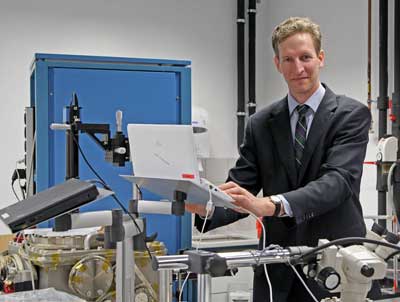| Posted: May 16, 2018 |
Processes in the atomic microcosmos are revealed
(Nanowerk News) Physicists at Friedrich-Alexander-Universität Erlangen-Nürnberg (FAU) have successfully generated controlled electron pulses in the attosecond range. They used optical travelling waves that are formed by laser pulses of varying wavelengths. The movements of electrons in atoms were revealed using attosecond free-electron pulses.
|
|
The findings of the researchers from Erlangen have been published in Physical Review Letters ("Ponderomotive Generation and Detection of Attosecond Free-Electron Pulse Trains").
|
|
Scientists have been researching ways of generating packets of electrons in extremely short timescales for several years. Such pulses enable ultrafast movements to be tracked, for example vibrations in atomic lattices, phase transitions in materials or molecular bonds in chemical reactions.
|
|
'The shorter the pulse, the faster the movements that can be mapped,' explains Prof. Dr. Peter Hommelhoff, Chair of Laser Physics at FAU. 'However, this also involves the special challenge of how to control the packets of electrons.'
|
 |
| Prof. Dr. Peter Hommelhoff, Chair of Laser Physics at FAU. (Image: FAU/Georg Pöhlein)
|
|
Last year, Hommelhoff and his team successfully generated periodic electron pulses with a duration of 1.3 femtoseconds - a femtosecond is one quadrillionth of a second. To do so, they directed a continuous beam of electrons over a silicon lattice and superimposed it with the optical field of laser pulses.
|
From femtosecond to attosecond pulses
|
|
The researchers at FAU have now gone one better and have generated electron pulses of 0.3 femtoseconds or 300 attoseconds. Lasers were also used for this method. Firstly, packets of electrons are emitted from an electron source using ultraviolet laser pulses. These packets then interact with optical travelling waves that are formed in a vacuum by two infrared laser pulses of varying wavelengths.
|
|
'The ponderomotive interaction causes a shift in the electron density,' explains Norbert Schönenberger, a researcher at Prof. Hommelhoff's Chair and co-author of the study. 'We break down the electron packet to a certain extent into even smaller packets to generate electron pulses in the attosecond range. The time delay in the arrival of the laser beams enables us to generate specific travelling waves and thus precisely control the trains of pulses.'
|
|
This method developed by the physicists at FAU could revolutionise experiments in electron diffraction and microscopy. In future, attosecond pulses will not only be able to be used to trace the movements of atoms , but also even to show the dynamics of electrons within atoms, molecules and solid bodies.
|

